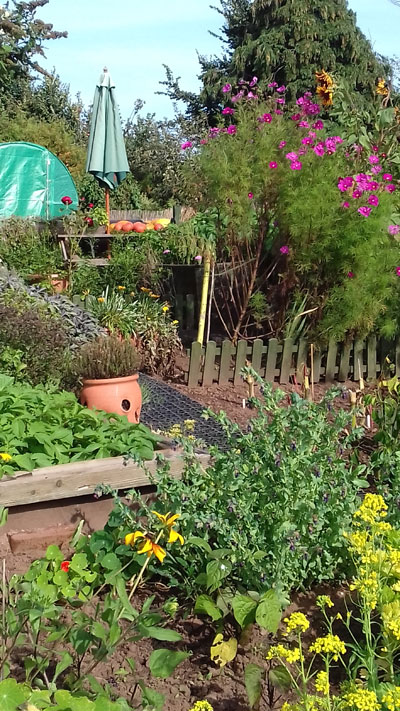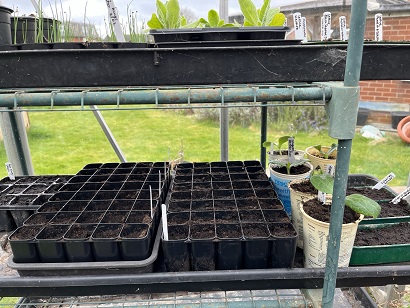 I haven't done as much work as normal on the wildlife plot this month as I am recovering from surgery and can't really do gardening of any sort. One thing I can do though is sow seeds so I have delayed my seed sowing and started towards the end of March. I normally stagger this type of activity but not this year. So, I hope like me the space where you bring on your seedlings is full.
I haven't done as much work as normal on the wildlife plot this month as I am recovering from surgery and can't really do gardening of any sort. One thing I can do though is sow seeds so I have delayed my seed sowing and started towards the end of March. I normally stagger this type of activity but not this year. So, I hope like me the space where you bring on your seedlings is full.
I have been on the lookout for some seed sowing containers that will last a lifetime to replace some of my cheap plastic ones that haven't lasted that long. First of all, let me say that I am not against all plastic just one-use plastic. After all, I would rather have plastic water pipes than lead ones, enviromesh rather than fleece that rips in the wind or cycle helmets, airbags in cars and child car seats all of which are made out of plastic.
I was given a range of seed trays to try out for Christmas so read on to see what I found out.
![]() The first modules I tried are made out of silicone, like baking containers are nowadays, called Sili-Seedlings starter tray. All of the things I tried cost slightly more but would only have to be bought once.
The first modules I tried are made out of silicone, like baking containers are nowadays, called Sili-Seedlings starter tray. All of the things I tried cost slightly more but would only have to be bought once.
These can only be bought from Amazon and are, for me, more the size of transplanting cells than seed sowing cells although they would work for larger seeds such as broad beans. Because they are silicone and it is floppy, you can't carry them like normal seed trays and I didn't really find them that easy to get the seedlings out of. They are squashable but perhaps a little too squashable.
There are six cells in each tray and you get two trays. Considering I grow about 40 broad bean plants at a time, that would make these cells quite expensive.
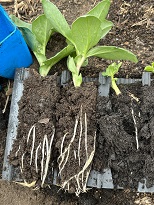 The next type of cell I tried was some rubber root trainers or as the company calls them RootCoaches. These smell and feel like my bicycle tyres especially when the greenhouse heats up. They are deep, like root trainers, so that seedlings that like to develop long root systems have the space to do so. The two sides clip together and each module can join on to the next one so that you can have them in a long line. These are very expensive. I have several sets of root trainers made out of the cheap, easily breakable plastic and they have lasted me over 10 years now so I do need something to replace them but these are not it.
The next type of cell I tried was some rubber root trainers or as the company calls them RootCoaches. These smell and feel like my bicycle tyres especially when the greenhouse heats up. They are deep, like root trainers, so that seedlings that like to develop long root systems have the space to do so. The two sides clip together and each module can join on to the next one so that you can have them in a long line. These are very expensive. I have several sets of root trainers made out of the cheap, easily breakable plastic and they have lasted me over 10 years now so I do need something to replace them but these are not it.
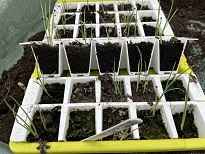 Then I tried the Bustaseed tray with easy tip out seedlings. That bit is true. The seedlings are easy to get out because there are only three sides to the cell. This worked well, the seedlings grew well and was very easy to water because of the tray underneath. Another advantage to this tray was the number of cells - 30 in all and so more like the number you would need for an allotment.
Then I tried the Bustaseed tray with easy tip out seedlings. That bit is true. The seedlings are easy to get out because there are only three sides to the cell. This worked well, the seedlings grew well and was very easy to water because of the tray underneath. Another advantage to this tray was the number of cells - 30 in all and so more like the number you would need for an allotment.
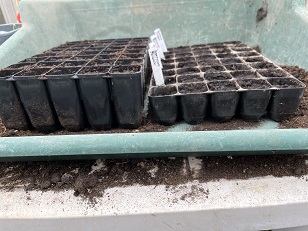 Having tried all of these, none of them are better than the Containerwise modules. They are made out of long-lasting plastic, easy to pick up as a whole tray, don't flex and the seedlings are easy to get out providing they are a little bit damp. In fact, I liked them so much I went to the company website and bought some of their deeper trays to grow beans and sweet peas in. they are twice the depth of the usual tray with the same number of cells.
Having tried all of these, none of them are better than the Containerwise modules. They are made out of long-lasting plastic, easy to pick up as a whole tray, don't flex and the seedlings are easy to get out providing they are a little bit damp. In fact, I liked them so much I went to the company website and bought some of their deeper trays to grow beans and sweet peas in. they are twice the depth of the usual tray with the same number of cells.
I also have a paper pot maker and a soil blocker, neither of which use plastic and both of which will last a lifetime. They have stood the test of time and I will continue to use them. You could also use toilet rolls , water them well before planting, plastic food containers of any sort, cut down waxed cardboard soup boxes alongside many other objects. There is no need nowadays to buy cheap plastic seed trays that will only last a few seasons.
